The Santee and Cooper Connection Began Early…
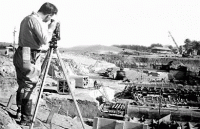 Even before the American Revolution, South Carolinians dreamed of using their rivers for commerce between the Midlands and the Lowcountry. After the war, the General Assembly chartered a company “for the inland navigation between the Santee and Cooper rivers.”
Even before the American Revolution, South Carolinians dreamed of using their rivers for commerce between the Midlands and the Lowcountry. After the war, the General Assembly chartered a company “for the inland navigation between the Santee and Cooper rivers.”
Under the leadership of Gov. William Moultrie, Revolutionary War heroes Gen. Francis Marion and Gen. Thomas Sumter, and other leaders such as John Rutledge and Henry Laurens, the 22-mile Santee Canal was constructed. It cost $750,000, a huge sum for that time.
The Santee Canal began operation in 1800. It linked the two rivers and enabled cargo-laden barges to travel from as far as 90 miles above Columbia, all the way to the port of Charleston.
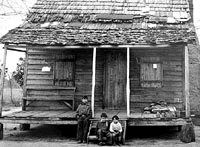
However, nature and the Industrial Revolution stepped in. Drought periodically dried the canal and the railroads and steamships provided faster and cheaper shipping. By 1850, the charter for the canal was revoked.
The concept of connecting the Santee and Cooper rivers to help support commerce was reborn in the 1920s as a dream of T.C. Williams, a Columbia businessman and entrepreneur.
He believed that a lowland hydroelectric project could provide that link. As owner of the Columbia Railway and Navigation Co., Williams was in the transportation business. He had the vision of carving out two huge lakes and building navigation locks that would provide a waterway for his steam-powered paddlewheel boats to and from Columbia to the port of Charleston.
Williams surveyed the swamps and woodlands of the Lowcountry, developing plans for a massive hydro and navigation project. In 1926 he obtained the federal license to construct it. But his dream came to a crashing halt with the Great Depression.
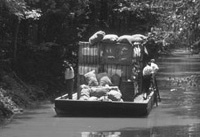 However, Williams’ dream was resurrected in 1933 by a group of resourceful legislators including a young man named Strom Thurmond. They obtained a promise from President Franklin D. Roosevelt for federally funding the project at a time when there were no funds available in the state’s meager $6 million budget.
However, Williams’ dream was resurrected in 1933 by a group of resourceful legislators including a young man named Strom Thurmond. They obtained a promise from President Franklin D. Roosevelt for federally funding the project at a time when there were no funds available in the state’s meager $6 million budget.
South Carolina legislators took note of the Great Depression “cures” being proposed in Washington under President Roosevelt’s New Deal administration. They determined that the rural areas of the state, among the last in the nation without power, should share in the benefits of electrification.
A persistent U.S. Sen. James F. Byrnes convinced President Roosevelt to provide the funding for something that would help pull a South Carolina out of an economic calamity.
Sen. Byrnes persuaded the president that lighting up and energizing the rural areas of the state, where 93 percent of the people were without electricity, could accomplish economic recovery. The means for doing that was to create the power-producing state utility that came to be known as Santee Cooper.
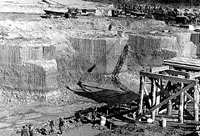 Electrifying the rural areas would improve the quality of life for those who lived there, Byrnes insisted. It would also provide the means to create jobs by allowing for the expansion of business and industry, which at the time were clustered primarily in the urban areas of the state. With passage of enabling legislation in 1934, the General Assembly created the South Carolina Public Service Authority. Its purpose was to construct and operate the Santee Cooper Hydroelectric and Navigation Project.
Electrifying the rural areas would improve the quality of life for those who lived there, Byrnes insisted. It would also provide the means to create jobs by allowing for the expansion of business and industry, which at the time were clustered primarily in the urban areas of the state. With passage of enabling legislation in 1934, the General Assembly created the South Carolina Public Service Authority. Its purpose was to construct and operate the Santee Cooper Hydroelectric and Navigation Project.
Private power companies fought the Santee Cooper idea all the way to the U.S. Supreme Court. Finally, in April 1939, their injunctions were overturned and work began. Santee Cooper was underway. Construction proceeded at a non-stop pace for 27 months.
Muscles, mules and machines were used to clear the swamps and woodlands, build the dams and dikes, and construct a powerhouse and navigation lock.
To continue reading the history of Santee Cooper click on each title below.
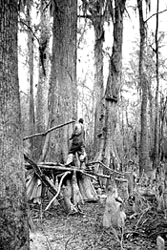 Establishing a malaria control program was the first job of all, a benefit for the entire state. Then came the clearing of the land–177,000 acres of swamp and timberland.
Establishing a malaria control program was the first job of all, a benefit for the entire state. Then came the clearing of the land–177,000 acres of swamp and timberland.
More than 12,500 workers, taken off the relief rolls in every county of the state, were hired and campsites built. Due to land clearing for impoundment of the two lakes, entire communities had to be relocated.
It was vital to keep them intact. They were moved or rebuilt. Even cemeteries were moved. Families who lived side by side for generations were kept together. Many of them actually ended up with more land or newer homes than when the project started, not to mention 100 free chickens for every farm family!
Over 200 million board feet of timber were harvested during the clearing operation and sold in a manner that did not disrupt the economic structure of that industry. Beginning at Pinopolis, the 225-square mile reservoir was excavated and 42 miles of dams and dikes were constructed. This included the 26-mile earthen dike that reaches 78 feet above the coastal plain. The Pinopolis Dam included the hydro station and navigation lock, the highest single-lift lock in the world.
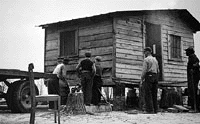 Sixty feet wide and 180 feet long, it still lifts boats 75 feet from the Tailrace Canal to the surface of Lake Moultrie. On the banks of the Tailrace Canal, adjacent to the hydro station, a switchyard was built—the hub of the transmission system for electricity generated by Santee Cooper. From this switchyard flowed electricity for distribution systems, electric cooperatives and major industrial users.
Sixty feet wide and 180 feet long, it still lifts boats 75 feet from the Tailrace Canal to the surface of Lake Moultrie. On the banks of the Tailrace Canal, adjacent to the hydro station, a switchyard was built—the hub of the transmission system for electricity generated by Santee Cooper. From this switchyard flowed electricity for distribution systems, electric cooperatives and major industrial users.
On the Santee River, an eight-mile-long earthen dam finally eliminated the periodic and life-threatening floods of the past. At the time, it was the longest earthen dam in the world. A 3,400-foot spillway was built to control floodwaters. Its 62 massive gates allowed spilling of excess water. In completing the largest earth-moving project in the nation’s history, 42 million cubic yards of earth were moved and 3.1 million cubic yards of concrete were poured. With no direct state investment in the project, South Carolina was the recipient of one of the wonders of the 20th century and resulted in one of its most valuable and ongoing resources. More importantly, the incalculable benefits of affordable power became available to virtually all South Carolinians.
Since its beginning, no South Carolina tax-generated revenues have ever been appropriated by the General Assembly for the design, construction, operation or maintenance of the Santee Cooper system. By law, the state of South Carolina is never to be financially obligated by Santee Cooper.
Santee Cooper has met the needs of the people it serves, expanded its electric generating capability, increased its services, and through the electric cooperatives, brought affordable power to the rural areas of South Carolina.
The 1934 legislation, which enabled the state to obtain federal grants and loans under the Roosevelt administration’s public works programs, defined the purposes of Santee Cooper… purposes for which the state-owned utility is still accountable:
- Provide affordable electric power for South Carolina homes, businesses and industries
- Develop the Santee, Cooper and Congaree rivers for navigation
- Reclaim and drain swamplands
- Reforest the watersheds of the state’s rivers
To fulfill these sharply defined purposes, Santee Cooper has evolved specific programs dedicated to:
- Generation and transmission of electricity
- Treatment and transmission of water distributed by Lowcountry water agencies
- Recreational uses of Lakes Marion and Moultrie and surrounding areas
- Water management, including flood control and navigation on the lakes
- Economic development, which relies on the availability of low-cost electric power
- Environmental protection of plant and animal life
As a state utility, Santee Cooper is owned by the citizens of South Carolina who use its power and benefit from its other resources. This unique relationship provides many advantages to the people of South Carolina, including:
- Lower Electric Rates – Santee Cooper’s rates are among the lowest in the state and in the Southeast.
- A Yardstick for Power Costs – Santee Cooper serves as a measure by which a fair determination can be made for power costs and quality of service by investor-owned as well as public power utilities.
- Customer and Community Response – Santee Cooper has grown to answer the energy needs of the areas it serves, including the use of a variety of fuel sources and new technologies.
- Economic Growth – By providing low-cost power, Santee Cooper has helped bring in new industry and expand existing industry, resulting in thousands of new jobs.
- Resource Management – Virtually endless recreational opportunities are provided to South Carolinians and visitors who use lakes Marion and Moultrie.
Environmental Stewardship – Many native species have been preserved through effective resource management. The use of generation byproducts provides new resources to the state. - Flood Control – Thousands of acres of prime forest and farmland are protected from periodic inundation.
Navigation – Watercraft have the ability to travel from the Atlantic Ocean to the South Carolina Midlands by passage through the 75-foot Pinopolis Lock at the Jefferies Hydro Station.
As one of the largest power providers in South Carolina, Santee Cooper directly serves more than 187,000 residential and commercial customers in Berkeley, Horry, and Georgetown counties and generates the electricity distributed to the state’s 20 electric cooperatives. With a diverse fuel and energy supply of coal, nuclear, oil, gas and hydro, Santee Cooper also supplies power to 28 large industries, the municipal utilities in Bamberg and Georgetown, and the Charleston Air Force Base.
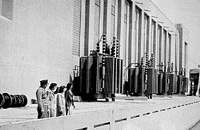 The people of South Carolina govern Santee Cooper through a board of directors appointed by the governor and approved by the state Senate. A board member represents each congressional district and each of the three counties where Santee Cooper serves retail customers directly; one board member has previous electric cooperative experience; and the chairman is appointed at-large.
The people of South Carolina govern Santee Cooper through a board of directors appointed by the governor and approved by the state Senate. A board member represents each congressional district and each of the three counties where Santee Cooper serves retail customers directly; one board member has previous electric cooperative experience; and the chairman is appointed at-large.
Only three other publicly owned state, municipal or district power systems in the U.S. sell more kilowatt-hours than Santee Cooper. Those public power resources serve much larger markets in New York, Los Angeles and Arizona.
At the same time, Santee Cooper ranks only eighth in revenue – a good indication that through its low rates and reliable service Santee Cooper has remained mission driven and is continuously fulfilling its original mandate to operate “for the benefit of all the people of the state.”
The commitment of Santee Cooper-to serve in the best interest of its customers, employees, bondholders and the people of South Carolina – is best expressed as part of the enabling legislation passed in 1934.
The General Assembly established Santee Cooper “for the benefit of all the people of the state, for the improvement of their health and welfare and material prosperity, and are public purposes, and being a corporation owned completely by the people of the state.
That mandate is what Santee Cooper and public power in South Carolina are all about.

